Part One - Dietary Needs of Parrots
For many years captive parrots were fed a mixture of dried seeds – ‘parrot mix’ for the larger species, and ‘parakeet mix’ for the smaller ones. These mixtures included small grass seeds, millets, oats, wheat, dried corn, safflower, sunflower, and usually pine nuts and peanuts (groundnuts). These seed mixes are still actively promoted by the pet trade as being ‘a balanced diet’ for parrots, and traditional bird-keepers are reluctant to consider any alternatives.
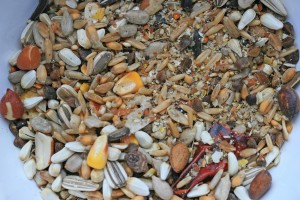
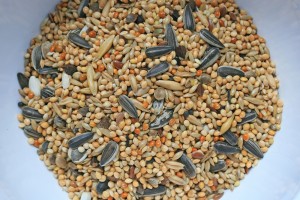
Conventially supplied dry seed mixes for 'parrots' (left) and 'parakeets' (right)
However, there are thousands of parrot species in a wide variety of shapes and sizes and from many different environments. It is therefore unreasonable to suppose that this ‘one size fits all’ philosophy could possibly work. Broadly speaking, parrots may be divided into grain eaters (including seeds, nuts, and beans) like budgerigars and parakeets; fruit eaters like most Amazon and Eclectus parrots; and specialist nectar eaters (lories and lorikeets).
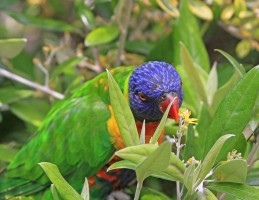
Rainbow Lory feeding on flowers
Other domesticated animal species have had their dietary requirements extensively researched for many decades, and we are well-used to feeding proprietary formulated diets to puppies, kittens, geriatric dogs and cats, kidney patients, horses, cattle, even koi carp. All have their own specially-prepared diets containing their required nutrients in exact percentages.
Dietary research on avian species, on the other hand, until recently had fallen far behind. The nutritional requirements for domesticated poultry were well-documented because of their commercial importance in the human food chain. The only other species to have similar research to any extent was the cockatiel (Nymphicus hollandicus). Extrapolating this limited information from chickens and cockatiels to encompass the needs of all other parrot species is obviously fraught with danger and liable to error.
In nature, small parakeets (including budgerigars) from fairly arid areas do in fact feed on seeding grasses, and in times of drought these may approach the dry, mature seeds that we offer in a parakeet mix. However, for much of the year, especially in the breeding season, these birds will take younger, fresher, greener shoots, flowers, and seed heads. Parrots and parakeets from wetter tropical areas are facultative omnivores – that is, they will feed on pretty much anything and everything that is available and reasonably palatable. They will forage through the rainforest canopy eating buds, shoots, flowers, leaves and fruits as they come into season, as well as the occasional grub or insect. They may gorge themselves on one particular favourite fruit when it is at its peak, but then will move on to another part of their feeding territory and a different plant. During the course of a year they will take in a wide range of nutrients, generally achieving a natural balance of requirements in that time. There will be lean periods associated with the dry season and plants’ growing cycles, alternating with a ‘flush’ of optimum quality and quantity. This is generally when the birds time their breeding season, so that eggs and the subsequent chicks will receive the best possible sustenance. This is especially obvious in the more temperate arid areas, with marked wet and dry seasons. Poor growing seasons will be reflected in a lack of breeding success. Optimal nutrition is required for growth, breeding, and moulting. Outside of these periods in a bird’s life, it is able to survive on ‘maintenance rations’. In captivity, our parrots are dependent upon us to provide them with food of the right quality and quantity at appropriate stages in their lives.
Parrots will select food items according to colour and taste, although they have far fewer taste buds (approx. 350) than do humans (around 9000) (BS). In spite of this, wild parrots do appear to consume plant items that contain mild toxins that are gastro-intestinal irritants. Parrots have been seen gathering in huge numbers at ‘clay licks’ ingesting clay material from cliff walls. This is believed to provide the birds with a natural ‘indigestion agent’ to protect their stomach linings from such irritants.
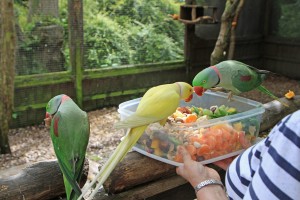
Parakeets offered a variety of fruits and vegetables at a bird park. They will select their favourites from the mix
There is anatomical and physiological variation in the gastro-intestinal tracts of birds, resulting from their different dietary constituents and digestive processes. Therefore, feeding all parrots the same type of basic mix will obviously create problems. Parrots’ digestive systems can vary through their lives to accommodate changes in diet, either seasonally, or with age (BS).
Parrots are very dextrous with their beaks, muscular tongues, and feet, manipulating and exploring food items, delicately peeling them, or powerfully cracking open thick shells. Lories and lorikeets have a ‘brush-tongue’ with numerous tiny papillae on the tip that increase its surface area, and facilitate the collection of nectar and pollen.
CONSTITUENT FOOD GROUPS
All animals require the following classes of ingredients in their diet to survive, grow, reproduce, and remain healthy. Macronutrients have dietary levels measured in grams (BS), and include -
Fats are required as an energy source and for the utilisation and storage of fat-soluble vitamins. Recommended levels for parrots are quoted as 2% - 4% of the total dietary intake, much lower than is needed in productive species like poultry. The level will increase in the laying hen, as egg yolk has a high fat content, providing a valuable energy source to the developing embryo. Large macaws and African grey parrots are known to favour high-fat nuts such as palm nuts. Sunflower seeds, which form a major part of most commercial ‘parrot seed mixes’ contain 20% fat. These seeds are selectively consumed by parrots (especially African greys) because of their high fat content – just as humans like to eat crisps and chocolate!
Carbohydrates (sugars & starches) provide a rapidly metabolisable energy source, and are the only food constituents utilised by the central nervous system for this purpose. Quantities required vary widely, depending on physical activity, environmental temperature, and fat reserves. Free-living parrots in the winter are estimated to require 50% more energy intake than caged indoor birds.
Proteins are the essential ‘building blocks’ of the body, and are required to form muscle and all other body tissues, including feathers. Again, required levels are lower than those suggested for high-producing species like poultry, but levels of 10% - 15% of total dietary intake are suggested for maintenance, rising to 20% at times of rapid growth (chicks), egg production, or repair and replacement (recovery from illness or moulting). Seed-based diets are very low in available protein, and therefore parrots will consume large quantities of seed in an attempt to make up their daily percentage protein requirement, thereby consuming excessive amounts of fats and carbohydrates as well. Nectar feeders gather their protein in the form of flower pollen and some insect matter. When these birds are breeding, they will take animal protein in the form of insects or spiders to provide the higher levels of protein required by their growing chicks. Larger parrots will consume snails, fish, or even carrion for the same reasons.
Proteins are made up of constituent amino acids, which are absorbed after digestion and re-combined to form new protein molecules. Some amino acids may be manufactured in the body from constituent elements – non-essential amino acids, but others have to be taken in the diet – essential amino acids. Poor quality or insufficient dietary protein resulting in reduced intake of these essential amino acids will have profound effects on feather quality and colour, chick growth rates, and breeding performance.
WATER is as much an essential nutrient as all these other components: no living creature can survive without taking in water.
Micronutrients have dietary levels measured in micrograms (BS), and include vitamins and minerals.
Vitamins are required for many chemical processes and reactions in the body, and may be divided into fat-soluble (vitamins A, D, E and K), and water-soluble (vitamins B-complex and C). Fat-soluble vitamins are stored in the body, usually in the liver, allowing some latitude in lean times, provided sufficient have been taken in to store. However, this also means there is the potential for over-load if too much is present in the diet – this is encountered commonly with vitamins A and D. It is possible to have toxic effects – primarily kidney damage – with such a situation. Water-soluble vitamins, on the other hand, are excreted from the body without being stored, so any excess in the diet will be expelled. This obviously will mean that regular daily intake of these vitamins is required to maintain the bird’s needs, and therefore full health.
Vitamin A will be found in dark green foods (kale, spinach, broccoli, sweet potato, peas and beans), carrot, sweetcorn peppers, and mango. Vitamin D is manufactured by the bird in its skin and preen gland, in response to ultraviolet radiation, but is also present in egg yolk, fish oils and milk. Many caged parrots are never exposed to unfiltered sunshine, and as such are unable to activate their own vitamin D. Whilst exposure to natural sunshine would be best, this is not always practical, and specific UVB light bird lamps should be used to ensure adequate exposure and help with calcium metabolism (BS). Ultraviolet Light & Skin Cancer Vitamin E is obtained from spinach, apples & pears, mango, almonds and walnuts, sweet potatoes, sunflower kernels, pine nuts, and wheatgerm. Vitamin K supply comes from green vegetables and eggs, as well as bacteria in the gut. This latter vitamin is especially required by fig parrots (Opopsitta & Psittaculirostris spp.)
Vitamin C is found primarily in apples, oranges, tomatoes, strawberries, kiwi fruit, and rose hips. It is also synthesised by the bird in its liver, so deficiency is rarely a problem. It does, however, enhance the absorption of iron, so too many vitamin C-rich foods may be a problem in birds susceptible to iron-storage disease. Vitamins of the B-group include thiamine (B1), riboflavin (B2), niacin, pyridoxine (B6), biotin, pantothenic acid, folic acid, choline and cyanocobalamin (B12). These are generally obtained from wheatgerm (wholemeal bread), dark greens, eggs, and sunflower.
Minerals are also essential to parrots for several important reasons. Calcium is arguably the most important (or at least the most widely studied), and is present in dark green foods, natural mineral sources such as oyster shell or cuttlefish bone, egg shells, cooked chicken bones, oranges, chick peas, bread or toast, and milk or milk-products such as cheese. It is often reported that parrots should not be given milk as they cannot digest it. This is true up to a point: they do not have the enzyme lactase to digest milk sugar (lactose), but the worst that will happen to a bird fed a large quantity of milk is that it will have transient diarrhoea. As a first-aid source of calcium it is invaluable, and a little hard cheese is enjoyed by most birds, as well as providing them with calcium and protein.
[When I discuss diets for parrots with my clients, and suggest giving cooked chicken bones as a valuable source of calcium and protein, the usual reaction is a grimace and the comment “Oh no, that is cannibalistic!” I can understand the reaction – a bird eating a piece of another bird – but strictly speaking, it is not cannibalistic, as this applies only to the same species. Chickens will attack and eat bits of each other, that is true, and very unpleasant, but giving a parrot a cooked chicken leg bone with a little meat on it once in a while does no harm at all. The bird will enjoy picking off the bits of meat and cracking the bone to extract the marrow. The meat and marrow are valuable sources of protein. I would never suggest feeding cooked chicken bones to cats or dogs: splinters of bone frequently become lodged in the mouth, throat, or stomach. However, in over 30 years of avian veterinary practice I have never seen such a problem in parrots. These birds seem to crush the bone with their powerful beaks before swallowing it, and the tough lining of the gizzard completes the grinding process. I am more reluctant to recommend pork or lamb chop or rib bones, purely because of the higher fat content, but I do have clients who give these items to their birds, with no obvious problem – as long as they are not fed to excess. Like many food items, parrots tend only to pick off the prime pieces, and would rarely in any case consume the whole bone. Cooked fish is another valuable source of animal protein and its constituent amino acids, but raw fish contains thiaminase, which will destroy the B-vitamin thiamine.]
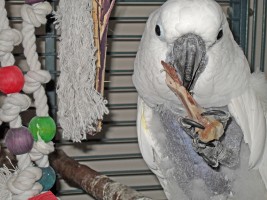
Umbrella Cockatoo eating the marrow out of a cooked chicken thighbone
Calcium is required for bone formation, feather production, egg shell manufacture, and normal nerve and muscle function. Phosphorus is closely linked with calcium, and is also essential for bone formation. However, the ratio of calcium to phosphorus in the diet should be around 2:1. Phosphorus is contained in most foodstuffs, especially seeds and vegetables, while dry seeds are very low in calcium. Thus the conventional ‘parrot seed mix’ will have a Ca:P ratio of 1:10 or worse, resulting in serious calcium deficiency.
Iron is essential for haemoglobin, the oxygen-carrying pigment in red blood cells, and is found in fish and meat products, and wholemeal bread.
Many other minerals are required in smaller quantities, some so minute as to be termed trace elements. Magnesium is linked with calcium and phosphorus in bone formation, as well as enzyme activity. It is found in wheatgerm and sunflower. Copper is linked with iron in haemoglobin manufacture, and also in enzyme activity. It is present in meat, wheatgerm, nuts and oily seeds. Zinc is essential for the hormone insulin, and many enzyme activities. Selenium is required in digestive processes and hormone manufacture, as well as having an anti-oxidant effect. Manganese is essential for cartilage and bone growth, as well as reproductive function and egg-shell manufacture. All three of these minerals are found in meats and fish, bone, wheatgerm, and some oily seeds.
Iodine is an important element for proper function of the thyroid gland, which in turn controls skin and feather quality as well as metabolic rate. Also present in wheatgerm and egg, as well as fish and seaweed products. Sodium, Chlorine and Potassium are additionally required for proper growth and development, but are present in plentiful amounts in most food items.
Problems caused by deficiency or excess of these vitamins and minerals will cover a range of diseases.
FIBRE & GRIT
A certain amount of ‘roughage’ is essential in the diet to aid the digestive process. This is generally obtained in the form of cellulose fibres in fruits and vegetables. The addition of grit to the diet of parrots is contentious. It appears to be necessary for the smaller species that naturally consume a high-seed diet, such as budgerigars, cockatiels and grass parakeets. Larger parrots appear to manage perfectly well without it, and in fact may develop impaction problems if it is provided. The muscular gizzard, with its tough koilin lining, is more than capable of grinding up food items without the aid of grit. If grit is used, it may be in the form of crushed oyster-shell, which gradually will be dissolved by stomach acid, giving up its calcium content to the bird in the process. Alternatively, it may be mineral grit – small pieces of stone, which is what parrots would naturally ingest in the wild. These are not digestible, but will gradually pass through the bird’s digestive system to be voided, so will need regular replacement. It is not really necessary to leave a large dish of grit permanently in place in your bird’s cage: access once a week is probably sufficient. Alternatively scatter a little across the floor, or sprinkle it over the food.
So that is the theory of a balanced diet: how we put it into practice will be discussed in the next article.
© A K Jones BVetMed MRCVS, Chairman PSUK
